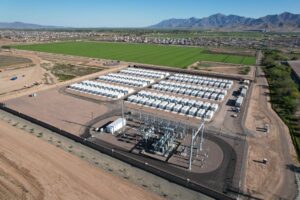SRP seeks to add battery storage to coal-fired plant site

The Salt River Project is exploring the option to add a cutting edge energy storage system to the Coronado Generating Station site in St. Johns for power generated by the growing number of solar and wind power plants in the region.
The experimental battery plant would store up to 50 megawatts for up to 10 hours. This would require breakthroughs in battery technology. The current generation of lithium-ion batteries used for grid-charged storage generally can’t store energy for more than about four hours.
Grid-charged battery systems help stabilize the power supply. They’re charged by wind, solar and other means, and can supply additional power to the grid as necessary. Battery systems that could last for 10 hours or more would make it easier to take full advantage of alternative energy sources like wind and solar. The wind farms create energy only when the wind is blowing, which might not be during peak use periods. The solar arrays don’t generate power at night. Battery backups can help bridge the gaps in both systems.
Wind and solar developers are racing to take advantage of the wide open spaces, intense sun and abundant wind in Arizona. But the lack of sufficient long-term storage for the power generated may leave SRP dependent on natural gas power plants, which can quickly ramp up output to meet peak demand but also produce heat-trapping pollutants.
“We’re seeking proposals from emerging storage technologies to consider how they could support achieving SRP’s sustainable power system of the future,” said Chico Hunter, Manager of Innovation and Development at SRP in a release. “We’re proud of SRP’s many lithium-ion battery storage projects coming online, and with the significant growth in our service territory, it is important we continue to pilot new types of energy storage technologies.”
The coal-fired Coronado Generating station is scheduled to shut down in 2032. Coal-fired plants are closing across the country, mostly due to the health effects of the soot they emit, and the heat-trapping nature of the waste gases they release.
SRP has 1.1 million electrical customers in the Valley and supplies 750,000 acre-feet of water annually to about half of the Valley’s residents. The utility relies heavily on a chain of dams on the Salt and Verde rivers, which gather up water from a 13,000-square-mile watershed.
SRP estimates it will need to double the energy it delivers in the next decade due to the state’s rapid growth.
SRP hopes to find an energy company that by 2028 can build a long-duration energy storage facility at its research facility in Florence. This will provide a protype for a much large facility at Coronado after the coal-burning plant is shut down.
The economy of rural Arizona has been hard hit by the shift away from coal-fired power plants. The closure of the Navajo Generating Station and the Peabody Coal Mine that supported it eliminated hundreds of high-paying jobs in the region. The planned shutdown of additional coal-fired plants like Cholla and Coronado will add to the economic effects.
The Biden Administration has declared its intention to get to a net-zero carbon electrical grid by 2050 by replacing coal- and gas-fired plants with wind and solar power.
The U.S. Department of Energy has launched the Long Duration Storage Shot to fund research to reduce the cost of long-term battery storage by 90%.by 2030. The federal infrastructure law is providing $505 million for energy storage demonstration projects and $6 billion to research battery materials process, manufacturing and recycling.
The record for a lithium-ion battery is now about eight hours.
Other promising technologies include liquid electrolyte flow batteries with an inverter that can convert direct current to alternating current. Those batteries use vanadium and zinc. Other approaches use batteries that compress air, gas or water in natural caverns combined with gravitational systems, according to a Leyline Renewable Capital report. In addition, batteries that rely on molten salt have also shown promise.
So far, none of the long-storage systems can compete with lithium-ion batteries.
A host of studies has suggested that the fine particles released by coal-burning power plants have big health effects on downwind populations. One study led by researchers from the Harvard School of Public health estimated that fine particulates from coal-fired plants between 1999 and 2020 were associated with 460,000 deaths in the U.S. That’s almost as many deaths as cigarettes cause annually.
Coal-fired power plants in 2022 accounted for almost 20% of greenhouse gas emissions in the U.S. and 55% of the emissions from the electric power sector.
It now costs less to generate energy from wind and solar plants than from a coal-fired plant, partly because operating the wind and solar arrays involves far fewer workers.
